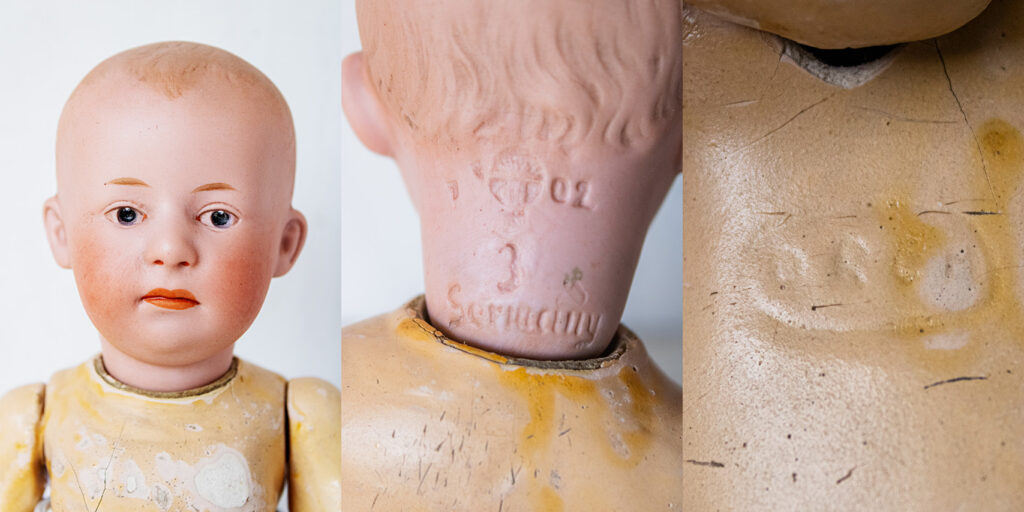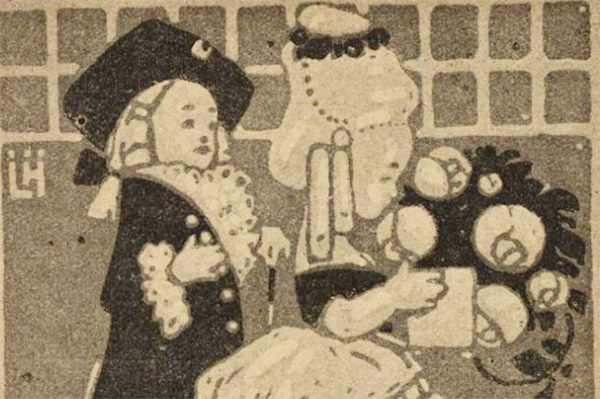First, one must not confuse “Gebruder Heubach” with Ernst Heubach, both of which are German doll manufacturers in the late 19th century.
Founded in 1820.
Heubach Doll Marks
Clara Fawcett, author of “Dolls: a Guide for Collectors,” wrote in 1947 that some Gebruder Heubach dolls bore the marks such as “G I 2 H” or “G 2 H.” She illustrates a doll named “Willoby” with typical elongated thighs, straight wrists, a big potruding belly, and a bisque head with the circular Heubach trademark that looks like a sun rising, with the letters DEP underneath, the word Germany and numbers. The doll was evidently made for the French market according to Fawcett. The marks that Fawcett mentions such as “G2H” do not appear in Cieslik’s German doll encyclopedia.
In 1882 the Heubach brothers registered their famous trademark of the rising sun. One can see this trademark in the 1913 publication of the Pottery, Glass, and Brass Salesman where they advertise having been founded in 1820.
During 1909 the brothers Heubach registered a trademark with the letter H inside a triangle, as announced in Sprechsaal (page 491).
Velhagen & Klasings Monatshefte in 1912 shows a Gebruder Heubach ad with a rectangular trademark. The name Heubach is separated HEU and BACH. (Click here to see this mark on a small 7246 head)

Doll heads made by the brothers Heubach started in 1910 and were only character faces. Some doll heads may have no mold mark but simply an “S” or “Q.” The S stook for “sun” representing the sun rising trademark and the Q stood for square (quadrat) representing the square trademark.
The Beginnings of Gebruder Heubach
Johann Heinrich Leder opened an earthenware and pottery factory in 1804. His cousins Heinrich and Wilhelm Liebmann succeded in ownership in 1833. Then in 1840 Christoph and Philipp Heubach bought the factory.
An interesting court case that occurred in New York mentions a “Gebruder Heubach” as brothers, sellers of stoneware, from Sonneberg, Germany in 1847 as plaintiffs in a case. They had hired someone or a firm known as A. Rolker & Mollman, the defendent, to act as an agent in New York and sell their goods there. The brothers in the case documented in 1853 probably were Philipp Heubach, his son Louis and Christoph’s son Anton.
The Heubach brothers founded their porcelain manufacturing company in 1870 according to the 1904 Official Catalogue for the Exhibition of the German Empire at the International Exposition in St. Louis.
The Handbook of European Commerce in 1872 (What to Buy and Where to Buy It; Being a Key to European Manufactures and Industry) mentions the Gebruder Heubach porcelain makers of Lichte, Germany near Wallendorf. The handbook describes lists establishments or manufacturers of porcelain, china goods, glass-ware, glass marbles, and beads found in Sonneberg. Gebruder Heubach of Lichte are in the list.
In 1876 Anton left the company and Louis Heubach’s 3 oldest sons join. Their names were Philipp Jr., Hermann and Ottokar.
1897 Leipzig Trade Fair
In the addressbook for the 1897 Leipzig Trade Fair the Heubach listing reads, “Gebrüder Heubach, Lichte near Wallendorf (Thuringia), porcelain factory and painting.-O.-V. Neumarkt 16, I (Hohmanns Hof).”
The Early 1900s

Four years earlier in 1900 they advertised they manufactured artistic porcelains such as figures, vases, flower-pots, figures of saints, porcelain pictures, and miniatures. The listing claims they had an agent in Paris named Etienne Seeloff at 25 rue Paradis, an agent in Berlin named Theodor Meyer, Kommandantenstr , and an agent in Bologna name C. Pedrelli e Figlio located at the Piazza San Martino 4B. They boasted 450 workmen at that time.
The St. Louis 1904 catalogue says they had a china factory with 500 workmen manufacturing paintings, art, fancy china, bisque figures, toy services, and toys.
In 1904 the German porcelain maker magazine lists an ad for the Gebruder Heubach company. It reads (in German) “Heubach brothers; A.-G., porcelain factory in Lichte near Wallendorf (8th-M.). Figures, babies, items for confectionery, vases, etc. Stot’s novelties.” In the same issue they also advertise their need for a correspondent for German, English, and French with experience in the ceramics industry.
That year they documented a net profit over 200,000 Marks and a dividend of 7 percent.
Gebruder Heubach: A Public Limited Company
According to the 1909 general report of the “Association of Ceramic Trades in Germany” Ottokar Heubach, kommerzienrat (commercial councilor), served on the executive board. At that time Philipp, Ottokar, and Richard Heubach served as directors of the Gebruder Heubach A. -G. Porcelain Factory, a public limited company.
In August 1909 they registered the following number marks:
6605, 6664, 6708, 6709, 6712-6714, 6721, 6722, 6728, 2729, 6735, 6743, 6752, 6755, 6756, 6758, 6759, 6762, 6764, 6769, 6772, 6779, 6780, 6782-6786, 6799, 6802, 6804, 6806, 6811, 6821, 6822, 6831, 6832, 6835, 6836, 6838, 6850
The same year they registered a trademark of a triangle with the capital letter H inside.

The doll head above bears the Heubach brother’s trademark with the rising sun registered in 1882. This particular doll head has molded painted eyes sometimes referred to as “intaglio eyes.” In 1911 The Heubach brothers registered a DRGM doll head with painted, deepened eyes known as intaglio eyes (to Americans).
This doll had a body with a mark on its side that reads DRGM inside an oval. The DRGM stood for “Deutsches Richsgebrauchsmuster” or “small patent.” DRGM marks might be found on many German products from porcelain, ceramics, or mixed-metal pieces. The mark was often seen listed in ads for patented products in German newspapers. Here it is found on a composition doll body which has no metal nor ceramics in its mixture. The DRGM marks dated pieces from around 1891 to 1944. The Heubach Brothers’ doll pictured above was given to a 7 year old American girl for Christmas in 1916.
1910 Leipzig Trade Fair Addressbook
Paul Zieller, Sculptor
A man named Paul Zieller worked as a designer for the Gebruder Heubach porcelain manufactory in Lichte, Thuringia. Some of his pieces appeared in The Studio Year-Book of Decorative Art in 1911. The year book claimed the Gebruder Heubach factory led the way in the design of artistic porcelain figurines with Paul Zieller, a sculptor from Berlin, who won a gold medal at the exhibition in Brussels. Some of the Heubach marks include a Z that could represent Zeiller.
The German magazine Velhagen & Klasings Monatshefte featured the porcelain designs of child doll busts and figurines in the volume two issue of 1912. The article includes images of some of the busts which can help one identify face molds. The faces vary from laughing to side glancing expressions. The author makes the claim that the Heubach porcelain painters used designs by local artists. The Heubach porcelain creations vary from doll heads, child head busts, vases, plate paintings, to animal figurines, statuettes, figurines around the electric lamps, tea sets, tableware, and clocks.
Awards
The Heubach brothers won a silver medal at the world fair in Paris in 1900, but continued on to win a gold medal at the World Exhibition in St. Louis in 1904. The kept this up at the exhibition in Milan in 1906 winning another gold medal for their work.

The SPRING SAMPLE FAIR LEIPZIG 1918 FAIR ADDRESS BOOK featured a full page ad for Gebruder Heubach. They advertised “porcelain paintings and portraits, artist dolls, and toys electrotechnical porcelain.
The Last Years of the Heubach Porcelain
Ottokar Heubach’s death is announced in 1919 in the Keramische Rundschau magazine.
In 1930 directors were Richard and Ernst Heubach with only 300 workers and 5 kilns.
Sadly, the century old firm does not survive the decade of the 1930s like so many others.
See more about other German antique dolls here.
